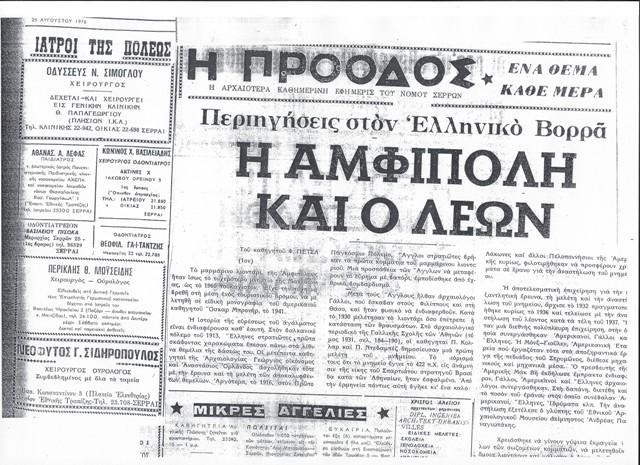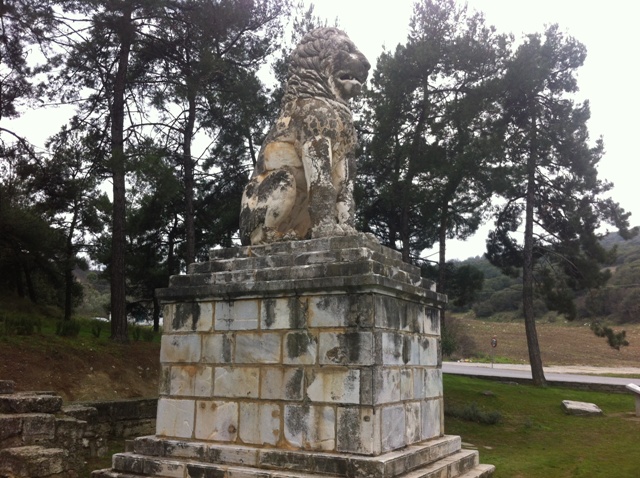Photos: Anastasia Balezdrova
Anastasia Balezdrova
Regardless of who rests in the Kasta tumulus near Amphipolis the Greek archaeologists are convinced that the excavations will uncover a unique monument. They have already agreed that the Lion of Amphipolis, which has been on the city road to the sea near the old bridge over Struma River for years, stood on top of the 30-metres-high grave, where it looked no less impressive, with a height of 5.30 metres, reaching 15.84 metres with the pedestal.
The story of its discovery, exploration and restoration fades into the troubled 20th century in the Balkans and contains a Bulgarian connection. According to the research by historians which GRReporter has found and presents today, the Bulgarian army prevented, albeit indirectly, parts of the monument from being taken to England. Historian and author of a lot of pieces of research of the region George Kaftantzis describes the events in the following way:
"In August 1916 British soldiers from the 8th Military Brigade and the 27th Division of the 16th Regiment of the British Army, who were engaged in the digging of trenches at the bridge near Amphipolis, found the marble parts of the lion and tried to carry them to the sea in order to take them to England (...). However, their attempt was interrupted by the Bulgarian army that had seized Pangaeo Mountain in the meantime and began to bomb the British soldiers."
Sources claim that shells were taken out from the debris years later.

Archaeologist Fotis Petsas, a long-time professor and dean of the Faculty of Philosophy at the University of Ioannina and head of archaeological services in different regions of Greece confirms the facts as well. In 1975 he returned to Central Macedonia where he continued his research of the regions of Vergina, Veria, Naoussa, Pella, Thessaloniki and Halkidiki. Petsas’ work on the history of the Lion of Amphipolis was published in 1976 in "Proodos" newspaper that circulated in Serres at that time.
"The story of the discovery of the monument is interesting in itself. During the Balkan War in 1913, Greek soldiers found the foundations of the pedestal of the monument while digging trenches. The foundations were examined by George Ikonomos and Anastasios Orlandos who subsequently became professors of archaeology. Later, in 1916, during World War I, British soldiers discovered the first parts of the marble lion. Their attempt to transport the pieces onboard a ship were thwarted by an enemy bombing."
Archaeologists from France arrived after the British, who conducted excavations in Philippi and Thassos and naturally expressed interest. In 1930 they examined the lion, as far as the condition of the parts allowed them to do so. The first study of the monument by Professors J. Pollard and P. Devambez was published in the archaeological bulletin of the French School in Athens. Their finding that the monument was built in 422 BC in memory of the victory of Spartan general Vrasidas against the Athenians was wrong. Their interpretation, however, had a positive result as many residents of Lakonia and other regions of the Peloponnese gave money in the fund raising campaign for the restoration of the monument."

According to the article the restoration works of the monument began in 1932 and ended in late 1937. "This was an international and multilateral operation that included Americans, French and Greeks ... The restoration of the lion was the work of sculptor of the National Archaeological Museum Andreas Panagiotakis."
According to Catherine Peristeri, the archaeologist who is in charge of the excavations of the Kasta tumulus, the lion and the sphinxes found at the entrance were made of the same material and by the same master, which proves that a person of high standing was buried there.
In her opinion, most probably the person was one of the generals or admirals in the army of Alexander the Great. "These are our suggestions but the truth will emerge when we enter the grave and determine the identity of the deceased," she said during the visit of Greek Prime Minister Antonis Samaras to the site.

What remains to be seen is how, after 1936, when the statue of the lion was attached to the pedestal again, it will stand again on top of the tomb that has kept its secret for so many centuries.
GRReporter would like to thank the State Central Library of Serres for their assistance in elaborating on the subject.